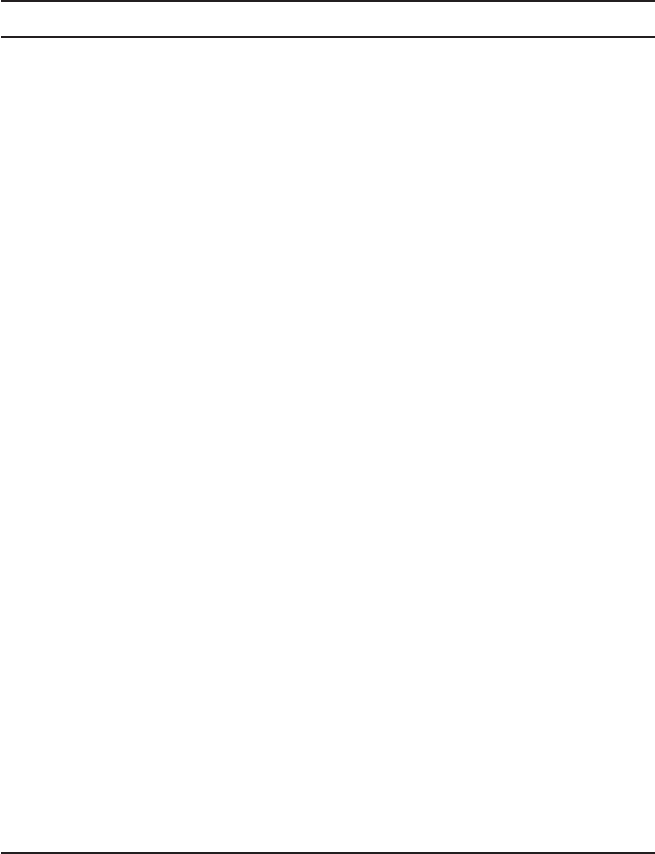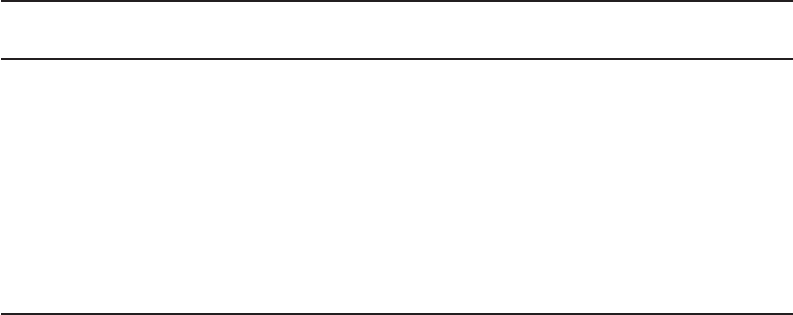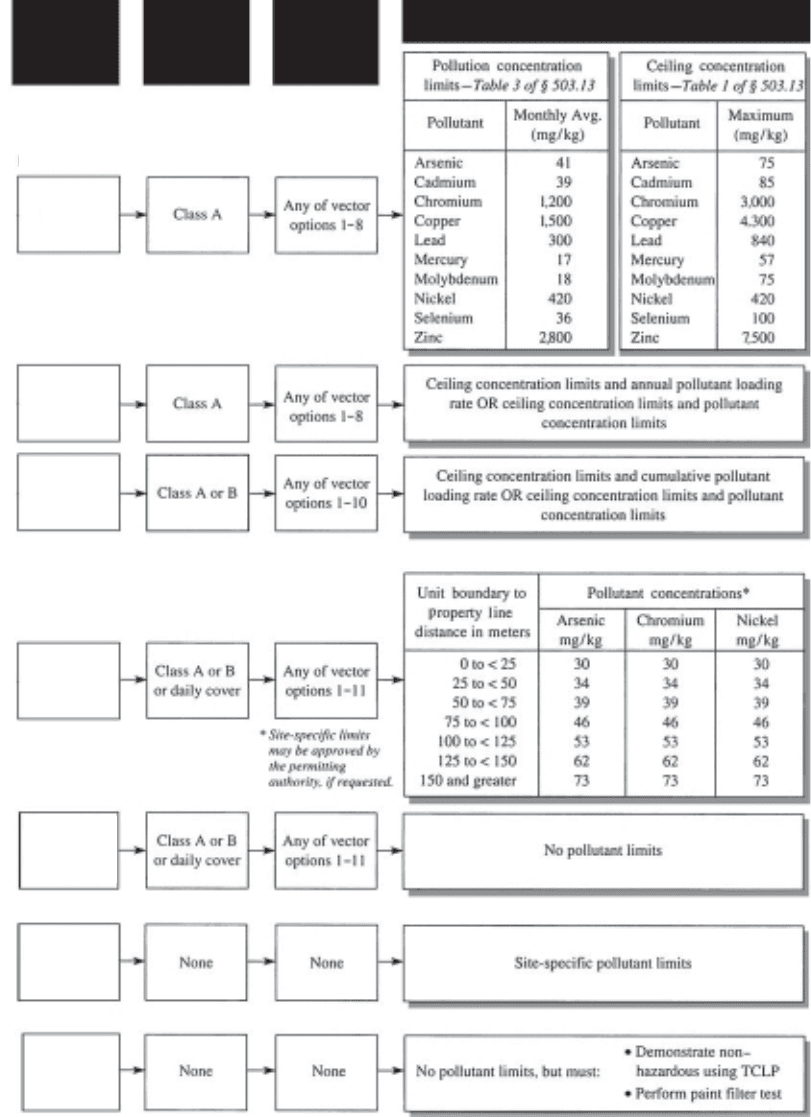Water and Wastewater Engineering
Подождите немного. Документ загружается.


18-8 WATER AND WASTEWATER ENGINEERING
a
Note: b biodegradable; i inert; n non; p particulate; s soluble.
b
Measured constituent values, based on the terminology given in this table, will vary depending on
the technique used to fractionate a particular constituent.
Source: Metcalf & Eddy, 2003.
TABLE 18-4
Definition of terms used to characterize important wastewater constituents used
for the analysis and design of biological wastewater treatment processes
Constituent
a, b
Definition
BOD
BOD or BOD
5
Total 5-d biochemical oxygen demand
sBOD Soluble 5-d biochemical oxygen demand
UBOD or BOD
u
Ultimate biochemical oxygen demand
COD
COD Total chemical oxygen demand
bCOD Biodegradable chemical oxygen demand
pCOD Particulate chemical oxygen demand
sCOD Soluble chemical oxygen demand
nbCOD Nonbiodegradable chemical ox
ygen demand
rbCOD Readily biodegradable chemical oxygen demand
rbsCOD Readily biodegradable soluble chemical oxygen demand
sbCOD Slowly biodegradable chemical oxygen demand
bpCOD Biodegradable particulate chemical oxygen de
mand
nbpCOD Nonbiodegradable particulate chemical oxygen demand
nbsCOD Nonbiodegradable soluble chemical oxygen demand
Nitrogen
TKN Total Kjeldahl nitrogen
bTKN Biodegradable total Kjeldahl nitrogen
sTKN Soluble (filtered) total Kjeldahl nitrogen
ON Organic nitrogen
bON Biodegradable organic nitrogen
nbON Nonbiodegradable organic nitrogen
pON Partic
ulate organic nitrogen
nbpON Nonbiodegradable particulate organic nitrogen
sON Soluble organic nitrogen
nbsON Nonbiodegradable soluble organic nitrogen
Suspended Solids
TSS Total suspended solids
VSS Volatile suspended solids
nbVSS Nonbiodegradable volatile suspended solids
iTSS Inert total suspended solids

GENERAL WASTEWATER COLLECTION AND TREATMENT DESIGN CONSIDERATIONS 18-9
Three typical compositions of untreated domestic wastewater are summarized in Table 18-5 .
Because there is no “typical” wastewater, it should be emphasized that these data should only be
used as a guide. The pH for all of these wastes will be in the range of 6.5 to 8.5, with a majority
being
slightly on the alkaline side of 7.0.
Characteristics of Industrial Wastewater
Industrial processes generate a wide variety of wastewater pollutants. The characteristics and
levels of pollutants vary significantly from industry to industry . The Environmental Protection
Agency (EPA) has grouped the pollutants into three categories: conventional pollutants, noncon-
ventional pollutants, and priority pollutants
. The conventional and nonconventional pollutants
are listed in Table 18-6 . The priority pollutants are listed in Table 2-11 in Chapter 2.
Weak Medium Strong
Constituent (all mg/L except settleable solids)
Alkalinity (as CaCO
3
)
a
50 100 200
Ammonia (free) 10 2550
BOD
5
(as O
2
)
b
100 200 300
Chloride
a
30 50 100
COD (as O
2
)250 500 1,000
Total suspended solids (TSS) 120 210 400
Volatile (VSS) 95 160 315
Fixed 255085
Settleable solids, mL/L 5 10 20
Sulfates
a
20 30 50
Total dissolved solids (TDS) 200 500 1,000
Total Kjeldahl nitrogen (TKN) (as N) 20 40 80
Total organic carbon (TOC) (as C) 75 150 300
Total phosphorus (as P) 5 10 20
TABLE 18-5
Typical composition of untreated domestic wastewater
a
To be added to amount in domestic water supply. Chloride is exclusive of contribution from
water-softener backwash.
b
For newer, tighter collection systems, or where water conservation is practiced, these numbers
may be considerably higher.
A dapted from Metcalf & Eddy, 2003.
TABLE 18-6
EPA’s conventional and nonconventional pollutant categories
Conventional Nonconventional
Biochemical oxygen demand (BOD
5
)Ammonia (as N)
Total suspended solids (TSS) Chromium VI (hexavalent)
Oil and grease Chemical oxygen demand (COD)
Oil (animal, vegetable) COD/BOD
7
Oil (mineral) Fluoride
(continued)

18-10 WATER AND WASTEWATER ENGINEERING
Conventional Nonconventional
pH Manganese
Nitrate (as N)
Organic nitrogen (as N)
Pesticide active ingredients (PAI)
Phenols, total
Phosphorus, total (as P)
Total organic carbon (TOC)
TABLE 18-6 (continued)
EPA’s conventional and nonconventional pollutant categories
Source: 40 CFR §413.02, 464.02, 467.02, and 469.12.
Because of the wide variety of industries and levels of pollutants, only a snapshot view of the
characteristics can be presented. A sampling of a few industries for two conventional pollutants
is shown in Table 18-7 .
A similar sampling for nonconventional pollutants is shown in Table 18-8 .
Industry BOD
5
, mg/L Suspended solids, mg/L
Ammunition 50–300 70–1,700
Fermentation 4,500 10,000
Food processing 100–6,900 30–3,500
Pulp and paper (kraft) 100–35075–300
Slaughterhouse (cattle) 400–2,500 400–1,000
Tannery 700–7,000 4,000–20,000
TABLE 18-7
Examples of industrial wastewater concentrations for BOD
5
and suspended solids
Industry Pollutant Concentration, mg/L
Coke by-product (steel mill) Ammonia (as N) 200
Organic nitrogen (as N) 100
Phenol 2,000
Metal plating Chromium VI 3–550
Nylon polymer COD 23,000
TOC 8,800
Plywood-plant glue waste COD 2,000
Phenol 200–2,000
Phosphorus (as PO
4
) 9–15
TABLE 18-8
Examples of industrial wastewater concentrations for nonconventional pollutants

GENERAL WASTEWATER COLLECTION AND TREATMENT DESIGN CONSIDERATIONS 18-11
18-3 WASTEWATER TREATMENT STANDARDS
In Public Law 92-500, the Congress required municipalities and industries to provide secondary
treatment before discharging wastewater into natural water bodies. The U.S. Environmental Pro-
tection Agency (EPA) established a definition of secondary treatment based on three wastewater
characteristics: BOD
5
, suspended solids, and hydrogen ion concentration (pH). The definition is
summarized in Table 18-9 .
PL 92-500 also directed that the EPA establish a permit system called the National Pollutant
Discharge Elimination System (NPDES). Under the NPDES program, all facilities that discharge
pollutants from any point source into waters of the Unite
d States are required to obtain a NPDES
permit. Although s ome states elected to have EPA administer their permit system, most states
administer their own program. Before a permit is granted, the administering agency will model
the response of the receiving body to the proposed discharge to determine if the receiving body is
adversely affec
ted. To maintain the quality of the receiving body of water, the permit may require
lower concentrations than those specified in Table 18-9 .
In addition, the states may impose additional conditions in the NPDES permit. For example,
in Michigan, a limit of 1 mg/L of phosphorus is contained in permits for discharges to surfa
ce
waters that do not have substantial problems with high levels of nutrients. More stringent limits
are required for discharges to surface waters that are very sensitive to nutrients.
CBOD
5
limits are placed in the NPDES permits for all facilities that have the potential to con-
tribute significant quantities of oxygen-consuming substances. The nitrogenous oxygen demand
from ammonia nitrogen is typically the oxygen demand of concern from municipal discharges.
It is
computed separately from the CBOD
5
and then combined to establis h a discharge limit.
Ammonia is also evaluated for its potential toxicity to the stream’s biota.
The limits for BOD
5
and nitrogen are often seasonally adjusted in colder climates because cold
water has a higher dissolved oxygen (DO) saturation value and because the biological activity is
TABLE 18-9
U.S. Environmental Protection Agency definition of secondary treatment
a,
b
a
Source: 40 CFR §133.102.
b
Present standards allow stabilization ponds and trickling filters to have higher 30-day average concentrations
(45 mg/L) and 7-day average concentrations (65 mg/L) of BOD and suspended solids as long as the water
quality of the receiving body of water is not adversely affected. Other exceptions are also permitted
. The CFR
and the NPDES Permit Writers’ Manual (U.S. EPA, 1996) should be consulted for details on the exceptions.
c
Not to be exceeded.
d
Average removal shall not be less than 85 percent.
e
Only enforced if caused by industrial wastewater or by in-plant inorganic chemical addition.
f
CBOD
5
carbonaceous BOD
5
. May be substituted for BOD
5
at the option of the permitting authority.
Characteristic
of discharge Units
Average monthly
concentration
c
Average weekly
concentration
c
BOD
5
mg/L
30
d
45
Suspended solids mg/L
30
d
45
Hydrogen ion
concentration pH units
Within the range 6.0–9.0 at all times
e
CBOD
5
f
mg/L 25 40

18-12 WATER AND WASTEWATER ENGINEERING
lower in cold water. In Michigan, the limits from May through November are more strict than from
December through April. For example, a BOD
5
limit in the winter may be 10 mg/L and 4 mg/L
in the summer while the NH
3
limit in the winter is set at 2 mg/L in the winter and 0.5 mg/L in the
summer.
To avoid anoxic conditions that might result from mixing a wastewater discharge with a very
low dissolved oxygen (DO) concentration with a river flow with a marginal DO level, the permit
may require the facility provide a minimum DO in the discharged wastewater. For example, DO
levels of 5 to 8 mg/L have been specified (Metcalf & Eddy, 2003).
Bacterial effluent limits may also be included in the NPDES permit. For example, municipal
wastewater treatment plants in Michigan must comply with limits of 200 fecal coliform bacteria
(FC) per 100 mL of water as a monthly average and 400 FC/100 m
L as a 7-day average. More strin-
gent requirements are imposed to protect waters that are used for recreation. Total-body-contact
recreation waters must meet limits of 130 Escherichia coli per 100 mL of water as a 30-day average
and 300 E. coli per 100 mL at any time. Partial-body-contact recreation is permitted for water with
less than 1,000 E. coli per 100 mL of water.
For thermal discharges such as cooling water, temperature limits may be included in the permit.
Michigan rules state that the Great Lakes and connecting waters and inland lakes shall not receive
a heat load that increases the temperature of the receiving water more than 1.7 C above the existing
nat
ural water temperature after mixing. For rivers, streams, and impoundments the temperature lim-
its are 1 C for cold-water fisheries and 2.8 C for warm-water fisheries.
An example of NPDES limits is shown in Table 18-10 . Note that in addition to concentration
limits, mass discharge limits are also established.
Total Maximum Daily Load
Under Section 303(d) of the 1972 Clean Water Act, states, territories, and authorized tribes are
required to develop lists of impaired waters. I mpaired waters are those that do not meet water
quality standards that the states, territories, and authorized tribes have established for them. This
assessment is ma
de after assuming that point sources of pollution have installed minimum levels
TABLE 18-10
NPDES limits for the city of Hailey, Idaho
a,
b,
c
a
This table outlines only the quantitative limits. The entire permit is 22 pages long.
b
Renewal announcement, 7 February 2001.
c
Source: U.S. EPA, 2005a.
Parameter
Average
monthly limit
Average
weekly limit
Instantaneous
maximum limit
BOD
5
30 mg/L 45 mg/L N/A
43 kg/d 64 kg/d
Suspended solids 30 mg/L 45 mg/L N/A
43 kg/d 64 kg/d
E. coli bacteria
126 colonies/100 mL N/A 406 colonies/100 mL
Fecal coliform bacteria N/A 200 colonies/100 mL N/A
Total ammonia as N 1.9 mg/L 2.9 mg/L 3.3 mg/L
4.1 kg/d 6.4 kg/d 7.1 kg/d
Total phosphorus 6.8 kg/d
10.4 kg/d N/A
Total Kjeldahl nitrogen 25 kg/d 35 kg/d N/A
GENERAL WASTEWATER COLLECTION AND TREATMENT DESIGN CONSIDERATIONS 18-13
of pollution control technology. The law requires that these jurisdictions establish priority rank-
ings for waters on the lists and develop total maximum daily loads (TMDL) for these waters. A
TMDL specifies the maximum amount of pollutant that a water body can receive and still meet
water quality standards. In addition, the TMDL allocates
pollutant loadings (that is, the mass of
pollutant) that may be contributed among point and nonpoint sources. The TMDL is computed
on a pollutant-by-pollutant basis for a list of pollutants. Additional categories include acids/bases
(measured as pH), pesticides
, and mercury. The TMDL computation is defined as:
TMDL WLA LA MOS
(18-1)
where WLA w a ste load allocations, that is, portions of the TMDL assigned to exis ting and
future point sources
LA load allocations, that is, portions of the TMDL assigned to existing and future
nonpoint sour
ces
MOS margin of safety
The MOS is to account for uncertainty about the relationships between loads and water quality.
A software system called Better Assessment Science Integrating Point and Nonpoint Sources
(BASINS) that integrates a geographic information system (GIS), national watershed and meteo-
rological data, and state-of-the-art environmental assessment and mo
deling tools may be used to
develop the TMDL (Ahmad, 2002; U.S. EPA, 2005b).
Pretreatment of Industrial Wastes
Industrial wastewaters can pose serious hazards to municipal systems because the collection and
treatment systems have not been designed to carry or treat them. The wastes can damage sewers and
interfere with the operation of treatment plants. They may pass through the wastewater treatment
plant (WWTP) untreated or they
may concentrate in the sludge, rendering it a hazardous waste.
The Clean Water Act (CWA) gives the EPA the authority to establish and enforce pretreat-
ment standards for discharge of industrial wastewaters into municipal treatment systems. Specific
objectives of the pretreatment program are:
• To prevent the introduction of pollutants into WWTPs that will interfere with their opera-
tion, including interferenc
e with their use or with disposal of municipal sludge.
• To prevent the introduction of pollutants to WWTPs that will pass through the treatment
works or otherwise be incompatible with such works.
• To improve opportunities to recycle and reclaim municipal and industrial wastewaters and
sludge.
EPA has established “prohibited
discharge standards” (40 CFR 403.5) that apply to all non-
domestic discharges to the WWTP and “categorical pretreatment standards” that are applicable to
specific industries (40 CFR 405-471). Congress assigned the primary responsibility for enforcing
these standards to local WWTPs.
In the General Pretreatment Regulation
s, industrial users (IUs) are prohibited from introduc-
ing the following into a WWTP:
1 . Pollutants that create a fire or explosion hazard in the municipal WWTP, including, but
not limited to, waste streams with a closed-cup flash point of less than or equal to 60 C,
using the test methods specified in 40 CFR 261.21.
18-14 WATER AND WASTEWATER ENGINEERING
2. Pollutants that will cause corrosive structural damage to the municipal WWTP (but in no
case discharges with a pH lower than 5.0) unless the WWTP is specifically designed to
accommodate such discharges.
3. Solid or viscous pollutants in amounts
that will cause obstruction to the flow in the
WWTP resulting in interference.
4. Any pollutant, including oxygen-demanding pollutants (such as BOD), released in a dis-
charge at a flow rate and/or concentration that will cause interference with the WWTP.
5. Heat in amounts that will inhibit biological activity in the WWTP and result in interfer-
ence, but in no case heat in s
uch quantities that the temperature at the WWTP exc eeds
40 C unless the approval authority, on requ est of the publicly owned treatment works
(POTW), approves alternative temperature limits.
6. Petroleum oil, nonbiodegradable cutting oil, or products of mineral oil origin in amounts
that will cause interference or will pass through.
7. Pollutants that result in the presence of toxic
gases, vapors, or fumes within the POTW
in a quantity that may cause acute worker health and safety problems.
8. Any trucked or hauled pollutants, except at discharge points designated by the POTW.
18-4 SLUDGE DISPOSAL REGULATIONS
C urrent terminology distinguishes between sludge and biosolids. Sludge i s defined as solids
removed from wastewater during treatment. Solids that are treated further are called biosolids.
Biosolids are primarily organic , semisolid products that remain after biod
egradable solids are
stabilized biologically or chemically. They are suitable for beneficial use.
The regulations for the disposal of sewage sludge in municipal solid waste landfills is codi-
fied as 40 CFR Part 258. Because municipal wastewater residuals ty
pically represent a small
percentage of the waste at a codisposal site, they are not discussed here.
On February 19, 1993, the EPA prom ulgated risk-based regulations that govern the use or
dispos ition of biosolids. These regulations are cod ified as 40 CFR Part 503 and have become
known as the “5
03 Regulations.” The regulations apply to sewage slu dge generated from the
treatment of domestic sewage that is land-applied, placed on a surface disposal site, or inciner-
ated in an incinerator that accepts only sewage slud ge. The regulations do not apply to sludge
generated from treatment of ind
ustrial process wastes at an industrial facility, hazardous sew-
age sludge, sewage slud ge with polychlorinated biphenyl (PCB) concentrations of 50 mg/L or
greater, or drinking water sludge. The 503 regulations are “self-implementing.” This means that
permits are not required. However, conform ance to the regulation is
required for facilities that
land-apply their sewage sludge.Violations of the regulations are violations of the law. The fol-
lowing discussion is limited to the land application of bulk biosolids. The regulation should be
consulted for biosolids that are sold or given away.
Figure 18-3 s ummarizes the sludge quality requ
irements for u se or disposal. The regula-
tion establishes two levels of sewage sludge quality with respect to heavy-metal concentrations:
ceiling concentration limits and pollution concentration limits. To be land-applied, bulk sewage
slu dge must meet the pollutant ceiling concentration limit
s and cumulative pollutant loading
rates (CPLR) or the pollutant concentration limits ( Table 18-11 ). Bulk sewage s ludge applied
to lawns and home gardens must meet the pollutant concentration limits. Sewage slu dge sold

18-15
FIGURE 18-3
Sludge quality requirements for use or disposal practices.
Sell or give
away in bag or
other container
Bulk sewage
sludge applied
to:
Sewage sludge
incinerator
Municipal
solid waste
landfill
Sewage sludge
unit with
liner/leachate
collection
• Lawn or home garden
• Agricultural land, including pasture
• Forest land
• Public contact site
• Reclamation site
SURFACE
DISPOSAL
INCINERATION
CO-DISPOSAL WITH MUNICIPAL SOLID WASTE
Unlined
sewage sludge
unit
Final Use or
Disposal
Practice
Vector
Attraction
Reduction
Options
Pathogen
Reduction
Alternatives
Pollutant Limits
Bulk sewage
sludge applied
to:
LAND APPLICATION

18-16 WATER AND WASTEWATER ENGINEERING
or given away in bags must meet the pollutant concentration limits or the annual sewage sludge
product application rates that are based on the annual pollutant loading rates.
Land Application Management Practices
The general management practices that must be followed for bulk biosolids are summarized in
Table 18-12 .
Pollutant
Ceiling concentration
limits, mg/kg
Cumulative pollutant
loading rates,
kg/ha
Pollutant concentration
limits, mg/kg
Annual pollutant
loading rates,
kg/ha · y
Arsenic 75 41 41 2.0
Cadmium 85 39 39 1.9
Chromium 3,000 3,000 1,200 150
Copper 4,300 1,500 1,500 75
Lead 840 300 300 15
Merc
ury57 17 17 0.85
Molybdenum 75 18 18 0.90
Nickel 420 420 420 21
Selenium 100 100 36 5.0
Zinc 7,500 2,800 2,800 140
TABLE 18-11
Land application limits for heavy metals
a , b
a
Concentrations are on a dry-weight basis.
b
Source: 40 CFR Part 503.13.
Bulk biosolids cannot be applied to flooded, frozen, or snow-covered agricultural land, forests, public
contact sites, or reclamation sites in such a way that the biosolids enter a wetland or other waters of the
United States (as defined in 40 CFR Part 122.2), except as provided in a permit issued pursuant to Section
402 (NPDES permit) or Section 404 (Dredge and Fill Permit) of the Clean Water Act, as amended.
Bulk biosolids cannot be applied to agricultural land, forests, or reclamation sites that are 10 m or less
from U.S. waters, unless otherwise specified by the permitting authority.
If applied to agricultural lands, forests, or public
contact sites, bulk biosolids must be applied at a rate that
is equal to or less than the agronomic rate for the site. Biosolids applied to reclamation sites may exceed
the agronomic rate if allowed by the permitting authority.
Bulk biosolids must not harm or contribute to the harm of a threatened or endangered species
or result
in the destruction or adverse modification of the species’ critical habitat when applied to the land.
Threatened or endangered species and their critical habitats are listed in Section 4 of the Endangered
Species Act. Critical habitat is defined as any place where a threatened or endangered species lives and
grows during any stage of its life cycle. Any direct or indirect action (or the result of any direct or indirect
action) in a critical habitat that diminishes the likelihood of survival and recovery of a listed species is
considered destruction or adverse mo
dification of a critical habitat.
TABLE 18-12
Land-application management practices for bulk biosolids under U.S. EPA Part 503.12 rule

GENERAL WASTEWATER COLLECTION AND TREATMENT DESIGN CONSIDERATIONS 18-17
Pathogen Reduction Alternatives
Two levels of quality for pathogen densities (Class A and Class B) are defined in the regulation.
The implicit requirements for Class A pathogen reduction are that:
• Salmonella bacteria be less than 3 most probable number (MPN) of organisms per four
grams of total solids;
• Enteric viruses be less than 1 per four grams of total solids; and
• Viable helminth ova be less than 1 per four grams of total s
olids.
The Class B pathogen stand ard requires that the sludge have less than 2 million fecal coli-
forms per gram of sludge or that it be treated in a process to significantly reduce pathogens
(PSRP).
The Class A and Class B treatment alternatives are outlined in Table 18-13 . Processes to fur-
ther reduce pathogens (PFRPs) are summarize
d in Table 18-14 . Processes to significantly reduce
pathogens (PSRP) are described in Table 18-15 .
Class A:
In addition to meeting the requirements in one of the six alternatives listed below, fecal coliform or
Salmonella sp. bacterial levels must meet specific densities at the time of biosolids use or disposal, when
prepared for sale or giveaway in a bag or other container for application to the land, or when prepared to
meet the requirements in 503.10(b), (c), (e), or (f).
Alternative 1 Ther
mally treated biosolids: use one of four time-temperature
regimes
Alternative 2 Biosolids treated in a high pH-high temperature process: specifies pH,
temperature, and air-drying requirements
Alternative 3 For biosolids treated in other processes: demonstrate that the process can reduce
enteric viruses
and viable helminth ova. Maintain operating conditions used in
the demonstration
Alternative 4 Biosolids treated in unknown processes: demonstration of the process is
unnecessary. Instead, test for pathogens—Salmonella sp. bacteria, enteric
viruses, and viable helminth ova—at the time the biosolids are used or
dispose
d of or are prepared for sale or giveaway in a bag or other container for
application to the land, or when prepared to meet the requirements in 503. 10(b),
(c), (e), or (f)
Alternative 5 Use of PFRP: Biosolids are treated in one of the processes to further reduce
pathogens (PFRP)
Alternative 6 Use of a process equivalent to PFRP: biosolids are treated in a process equivalent
to one of the PFRPs, as determined by the perm
itting authority
TABLE 18-13
Pathogen reduction alternatives
(continued)
